Kellogg's: Impact of Workplace Culture and Structure on Performance
VerifiedAdded on 2020/10/22
|10
|2559
|497
Report
AI Summary
This report provides an in-depth analysis of Kellogg's, focusing on its modern workplace environment, organizational structure, and workplace culture. It examines the relationship between structure, culture, people, and organizational performance, highlighting the importance of a positive work environment and employee motivation. The report also delves into the combined impact of culture and structure on the organization, discussing factors like motivation, profit, communication, and innovation. Furthermore, it applies management theories, including scientific management and Maslow's hierarchy of needs, to understand Kellogg's approach to employee motivation and development. The conclusion summarizes the key findings, emphasizing the significance of culture and structure in driving organizational success and employee well-being. The report provides a detailed overview of Kellogg's workplace practices and their impact on the company's performance and employee satisfaction.
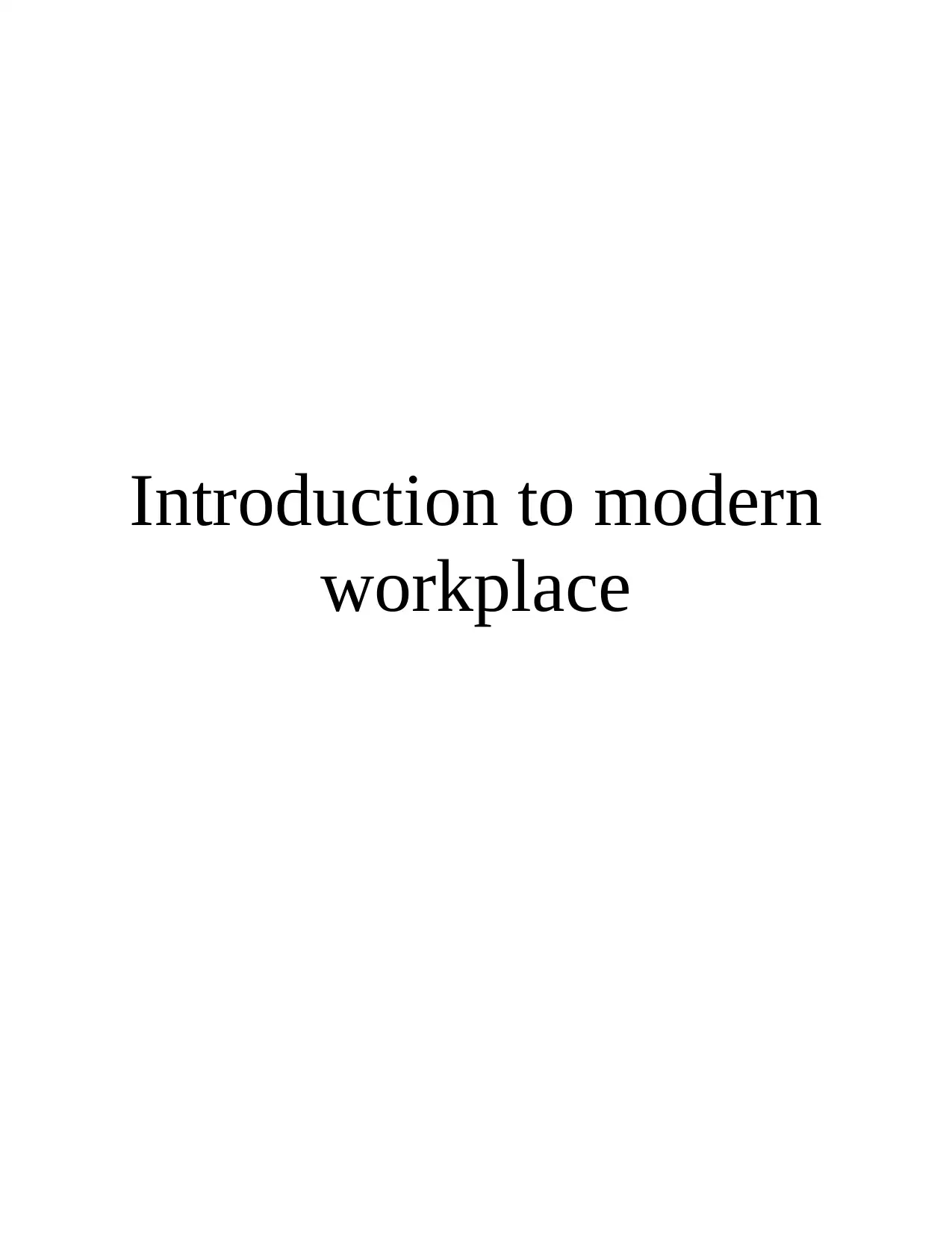
Introduction to modern
workplace
workplace
Paraphrase This Document
Need a fresh take? Get an instant paraphrase of this document with our AI Paraphraser
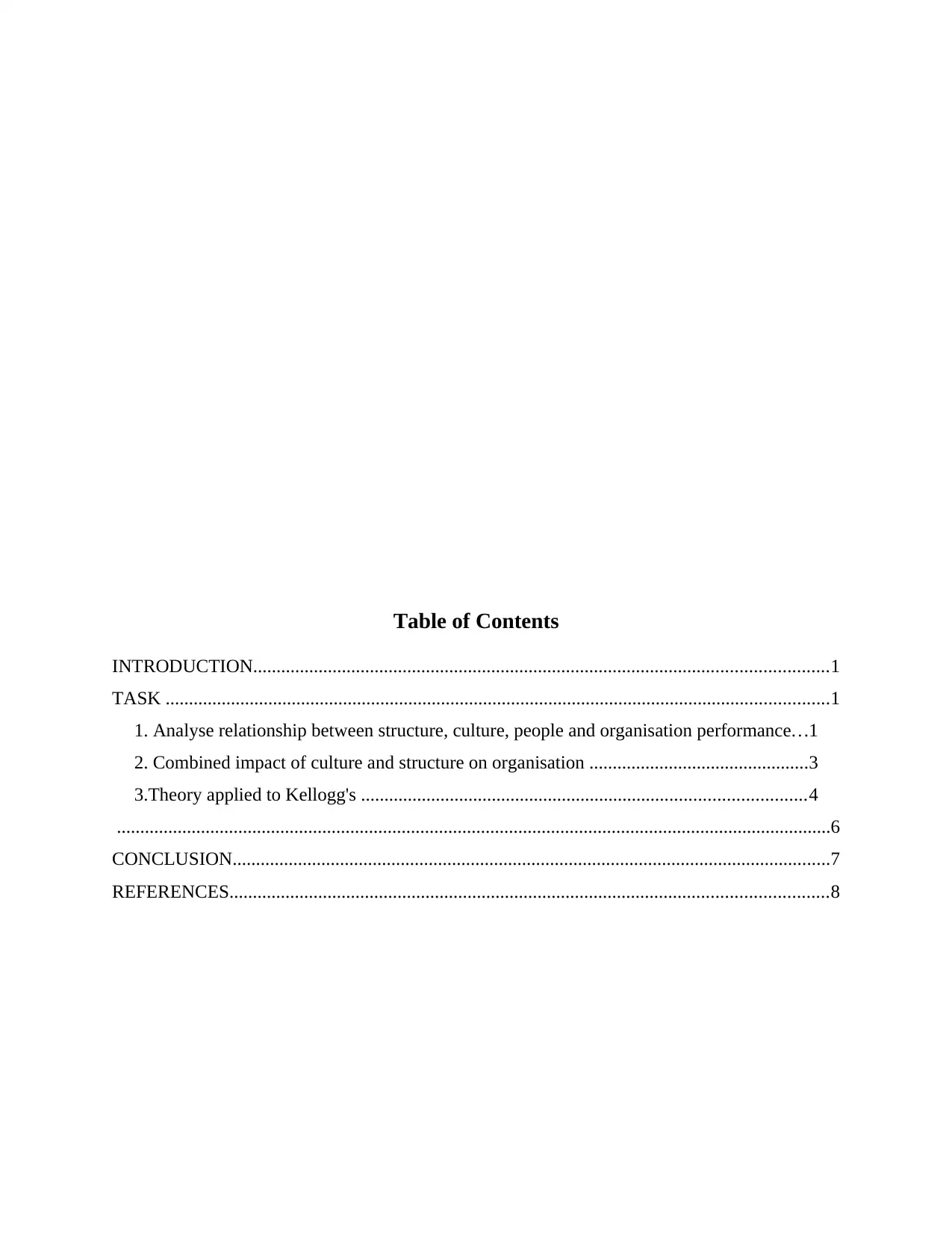
Table of Contents
INTRODUCTION...........................................................................................................................1
TASK ..............................................................................................................................................1
1. Analyse relationship between structure, culture, people and organisation performance...1
2. Combined impact of culture and structure on organisation ...............................................3
3.Theory applied to Kellogg's ...............................................................................................4
.........................................................................................................................................................6
CONCLUSION................................................................................................................................7
REFERENCES................................................................................................................................8
INTRODUCTION...........................................................................................................................1
TASK ..............................................................................................................................................1
1. Analyse relationship between structure, culture, people and organisation performance...1
2. Combined impact of culture and structure on organisation ...............................................3
3.Theory applied to Kellogg's ...............................................................................................4
.........................................................................................................................................................6
CONCLUSION................................................................................................................................7
REFERENCES................................................................................................................................8
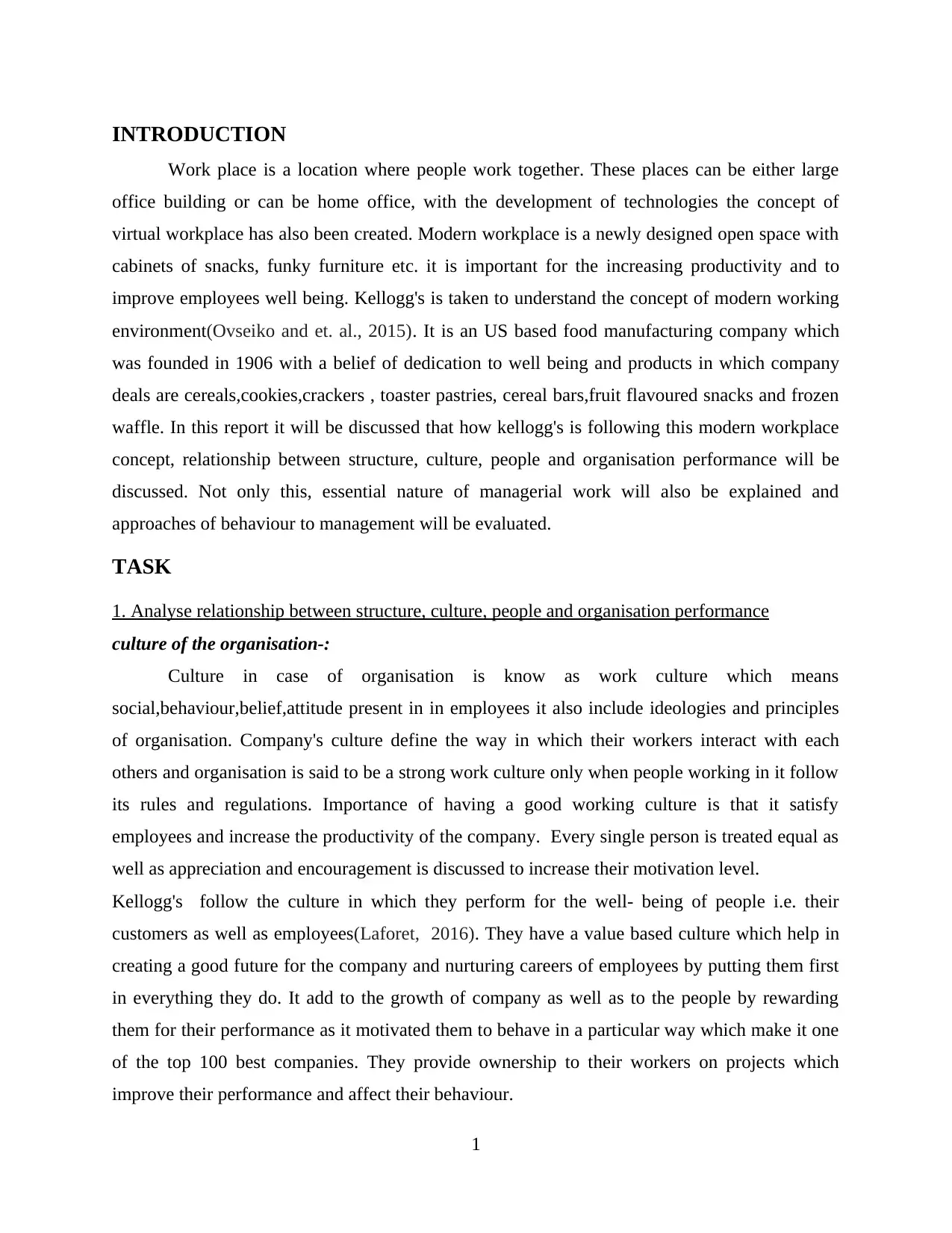
INTRODUCTION
Work place is a location where people work together. These places can be either large
office building or can be home office, with the development of technologies the concept of
virtual workplace has also been created. Modern workplace is a newly designed open space with
cabinets of snacks, funky furniture etc. it is important for the increasing productivity and to
improve employees well being. Kellogg's is taken to understand the concept of modern working
environment(Ovseiko and et. al., 2015). It is an US based food manufacturing company which
was founded in 1906 with a belief of dedication to well being and products in which company
deals are cereals,cookies,crackers , toaster pastries, cereal bars,fruit flavoured snacks and frozen
waffle. In this report it will be discussed that how kellogg's is following this modern workplace
concept, relationship between structure, culture, people and organisation performance will be
discussed. Not only this, essential nature of managerial work will also be explained and
approaches of behaviour to management will be evaluated.
TASK
1. Analyse relationship between structure, culture, people and organisation performance
culture of the organisation-:
Culture in case of organisation is know as work culture which means
social,behaviour,belief,attitude present in in employees it also include ideologies and principles
of organisation. Company's culture define the way in which their workers interact with each
others and organisation is said to be a strong work culture only when people working in it follow
its rules and regulations. Importance of having a good working culture is that it satisfy
employees and increase the productivity of the company. Every single person is treated equal as
well as appreciation and encouragement is discussed to increase their motivation level.
Kellogg's follow the culture in which they perform for the well- being of people i.e. their
customers as well as employees(Laforet, 2016). They have a value based culture which help in
creating a good future for the company and nurturing careers of employees by putting them first
in everything they do. It add to the growth of company as well as to the people by rewarding
them for their performance as it motivated them to behave in a particular way which make it one
of the top 100 best companies. They provide ownership to their workers on projects which
improve their performance and affect their behaviour.
1
Work place is a location where people work together. These places can be either large
office building or can be home office, with the development of technologies the concept of
virtual workplace has also been created. Modern workplace is a newly designed open space with
cabinets of snacks, funky furniture etc. it is important for the increasing productivity and to
improve employees well being. Kellogg's is taken to understand the concept of modern working
environment(Ovseiko and et. al., 2015). It is an US based food manufacturing company which
was founded in 1906 with a belief of dedication to well being and products in which company
deals are cereals,cookies,crackers , toaster pastries, cereal bars,fruit flavoured snacks and frozen
waffle. In this report it will be discussed that how kellogg's is following this modern workplace
concept, relationship between structure, culture, people and organisation performance will be
discussed. Not only this, essential nature of managerial work will also be explained and
approaches of behaviour to management will be evaluated.
TASK
1. Analyse relationship between structure, culture, people and organisation performance
culture of the organisation-:
Culture in case of organisation is know as work culture which means
social,behaviour,belief,attitude present in in employees it also include ideologies and principles
of organisation. Company's culture define the way in which their workers interact with each
others and organisation is said to be a strong work culture only when people working in it follow
its rules and regulations. Importance of having a good working culture is that it satisfy
employees and increase the productivity of the company. Every single person is treated equal as
well as appreciation and encouragement is discussed to increase their motivation level.
Kellogg's follow the culture in which they perform for the well- being of people i.e. their
customers as well as employees(Laforet, 2016). They have a value based culture which help in
creating a good future for the company and nurturing careers of employees by putting them first
in everything they do. It add to the growth of company as well as to the people by rewarding
them for their performance as it motivated them to behave in a particular way which make it one
of the top 100 best companies. They provide ownership to their workers on projects which
improve their performance and affect their behaviour.
1
⊘ This is a preview!⊘
Do you want full access?
Subscribe today to unlock all pages.

Trusted by 1+ million students worldwide
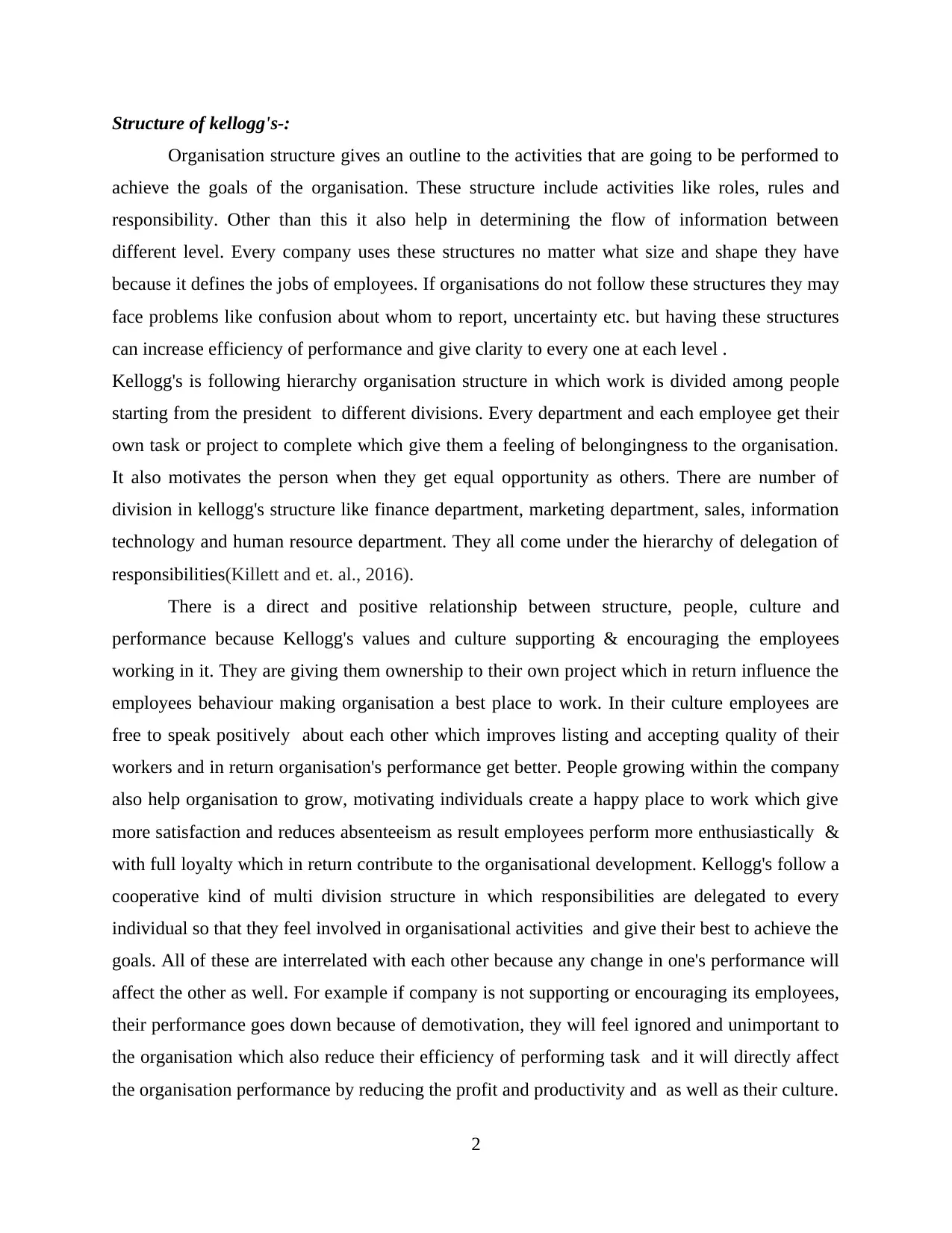
Structure of kellogg's-:
Organisation structure gives an outline to the activities that are going to be performed to
achieve the goals of the organisation. These structure include activities like roles, rules and
responsibility. Other than this it also help in determining the flow of information between
different level. Every company uses these structures no matter what size and shape they have
because it defines the jobs of employees. If organisations do not follow these structures they may
face problems like confusion about whom to report, uncertainty etc. but having these structures
can increase efficiency of performance and give clarity to every one at each level .
Kellogg's is following hierarchy organisation structure in which work is divided among people
starting from the president to different divisions. Every department and each employee get their
own task or project to complete which give them a feeling of belongingness to the organisation.
It also motivates the person when they get equal opportunity as others. There are number of
division in kellogg's structure like finance department, marketing department, sales, information
technology and human resource department. They all come under the hierarchy of delegation of
responsibilities(Killett and et. al., 2016).
There is a direct and positive relationship between structure, people, culture and
performance because Kellogg's values and culture supporting & encouraging the employees
working in it. They are giving them ownership to their own project which in return influence the
employees behaviour making organisation a best place to work. In their culture employees are
free to speak positively about each other which improves listing and accepting quality of their
workers and in return organisation's performance get better. People growing within the company
also help organisation to grow, motivating individuals create a happy place to work which give
more satisfaction and reduces absenteeism as result employees perform more enthusiastically &
with full loyalty which in return contribute to the organisational development. Kellogg's follow a
cooperative kind of multi division structure in which responsibilities are delegated to every
individual so that they feel involved in organisational activities and give their best to achieve the
goals. All of these are interrelated with each other because any change in one's performance will
affect the other as well. For example if company is not supporting or encouraging its employees,
their performance goes down because of demotivation, they will feel ignored and unimportant to
the organisation which also reduce their efficiency of performing task and it will directly affect
the organisation performance by reducing the profit and productivity and as well as their culture.
2
Organisation structure gives an outline to the activities that are going to be performed to
achieve the goals of the organisation. These structure include activities like roles, rules and
responsibility. Other than this it also help in determining the flow of information between
different level. Every company uses these structures no matter what size and shape they have
because it defines the jobs of employees. If organisations do not follow these structures they may
face problems like confusion about whom to report, uncertainty etc. but having these structures
can increase efficiency of performance and give clarity to every one at each level .
Kellogg's is following hierarchy organisation structure in which work is divided among people
starting from the president to different divisions. Every department and each employee get their
own task or project to complete which give them a feeling of belongingness to the organisation.
It also motivates the person when they get equal opportunity as others. There are number of
division in kellogg's structure like finance department, marketing department, sales, information
technology and human resource department. They all come under the hierarchy of delegation of
responsibilities(Killett and et. al., 2016).
There is a direct and positive relationship between structure, people, culture and
performance because Kellogg's values and culture supporting & encouraging the employees
working in it. They are giving them ownership to their own project which in return influence the
employees behaviour making organisation a best place to work. In their culture employees are
free to speak positively about each other which improves listing and accepting quality of their
workers and in return organisation's performance get better. People growing within the company
also help organisation to grow, motivating individuals create a happy place to work which give
more satisfaction and reduces absenteeism as result employees perform more enthusiastically &
with full loyalty which in return contribute to the organisational development. Kellogg's follow a
cooperative kind of multi division structure in which responsibilities are delegated to every
individual so that they feel involved in organisational activities and give their best to achieve the
goals. All of these are interrelated with each other because any change in one's performance will
affect the other as well. For example if company is not supporting or encouraging its employees,
their performance goes down because of demotivation, they will feel ignored and unimportant to
the organisation which also reduce their efficiency of performing task and it will directly affect
the organisation performance by reducing the profit and productivity and as well as their culture.
2
Paraphrase This Document
Need a fresh take? Get an instant paraphrase of this document with our AI Paraphraser
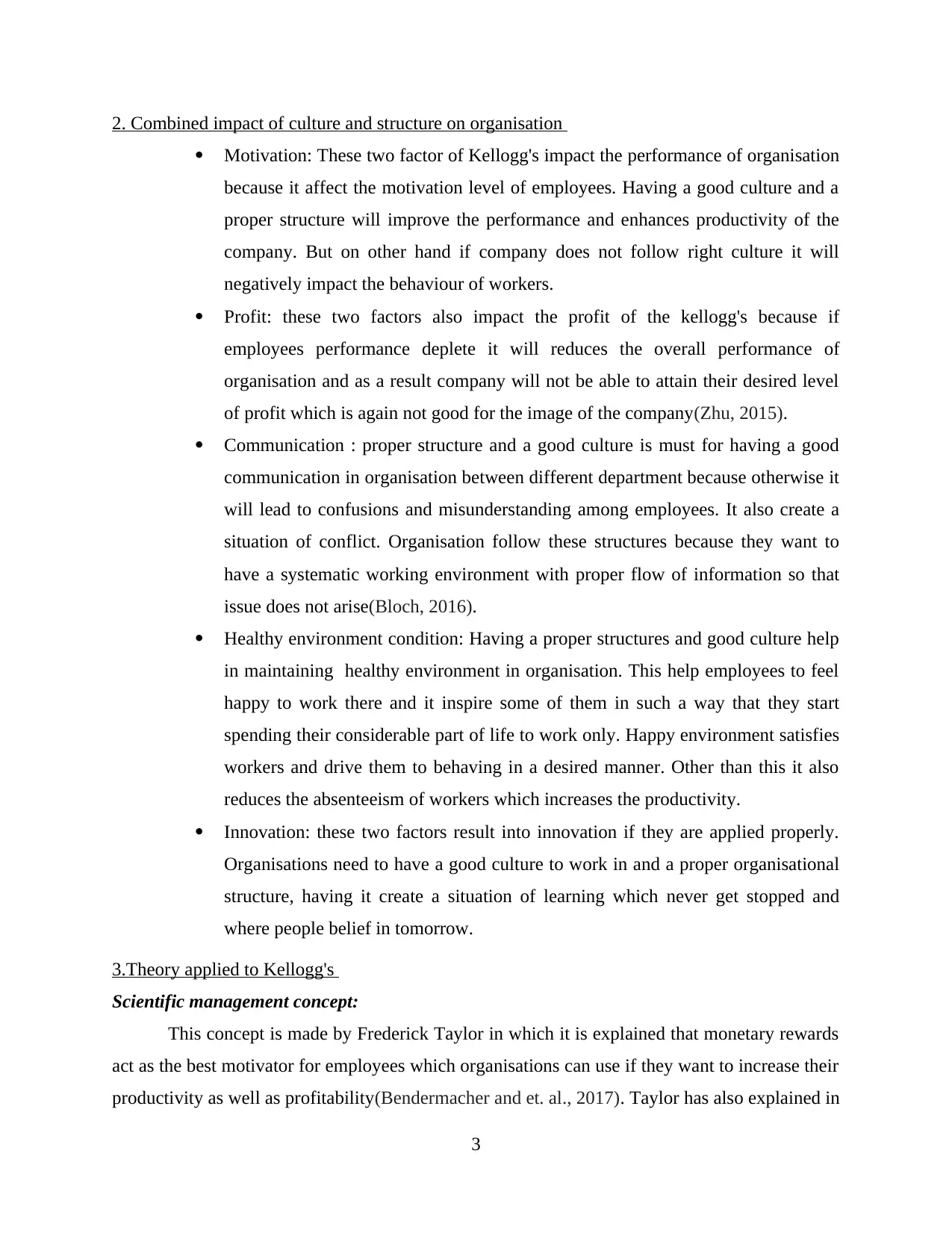
2. Combined impact of culture and structure on organisation
Motivation: These two factor of Kellogg's impact the performance of organisation
because it affect the motivation level of employees. Having a good culture and a
proper structure will improve the performance and enhances productivity of the
company. But on other hand if company does not follow right culture it will
negatively impact the behaviour of workers.
Profit: these two factors also impact the profit of the kellogg's because if
employees performance deplete it will reduces the overall performance of
organisation and as a result company will not be able to attain their desired level
of profit which is again not good for the image of the company(Zhu, 2015).
Communication : proper structure and a good culture is must for having a good
communication in organisation between different department because otherwise it
will lead to confusions and misunderstanding among employees. It also create a
situation of conflict. Organisation follow these structures because they want to
have a systematic working environment with proper flow of information so that
issue does not arise(Bloch, 2016).
Healthy environment condition: Having a proper structures and good culture help
in maintaining healthy environment in organisation. This help employees to feel
happy to work there and it inspire some of them in such a way that they start
spending their considerable part of life to work only. Happy environment satisfies
workers and drive them to behaving in a desired manner. Other than this it also
reduces the absenteeism of workers which increases the productivity.
Innovation: these two factors result into innovation if they are applied properly.
Organisations need to have a good culture to work in and a proper organisational
structure, having it create a situation of learning which never get stopped and
where people belief in tomorrow.
3.Theory applied to Kellogg's
Scientific management concept:
This concept is made by Frederick Taylor in which it is explained that monetary rewards
act as the best motivator for employees which organisations can use if they want to increase their
productivity as well as profitability(Bendermacher and et. al., 2017). Taylor has also explained in
3
Motivation: These two factor of Kellogg's impact the performance of organisation
because it affect the motivation level of employees. Having a good culture and a
proper structure will improve the performance and enhances productivity of the
company. But on other hand if company does not follow right culture it will
negatively impact the behaviour of workers.
Profit: these two factors also impact the profit of the kellogg's because if
employees performance deplete it will reduces the overall performance of
organisation and as a result company will not be able to attain their desired level
of profit which is again not good for the image of the company(Zhu, 2015).
Communication : proper structure and a good culture is must for having a good
communication in organisation between different department because otherwise it
will lead to confusions and misunderstanding among employees. It also create a
situation of conflict. Organisation follow these structures because they want to
have a systematic working environment with proper flow of information so that
issue does not arise(Bloch, 2016).
Healthy environment condition: Having a proper structures and good culture help
in maintaining healthy environment in organisation. This help employees to feel
happy to work there and it inspire some of them in such a way that they start
spending their considerable part of life to work only. Happy environment satisfies
workers and drive them to behaving in a desired manner. Other than this it also
reduces the absenteeism of workers which increases the productivity.
Innovation: these two factors result into innovation if they are applied properly.
Organisations need to have a good culture to work in and a proper organisational
structure, having it create a situation of learning which never get stopped and
where people belief in tomorrow.
3.Theory applied to Kellogg's
Scientific management concept:
This concept is made by Frederick Taylor in which it is explained that monetary rewards
act as the best motivator for employees which organisations can use if they want to increase their
productivity as well as profitability(Bendermacher and et. al., 2017). Taylor has also explained in
3
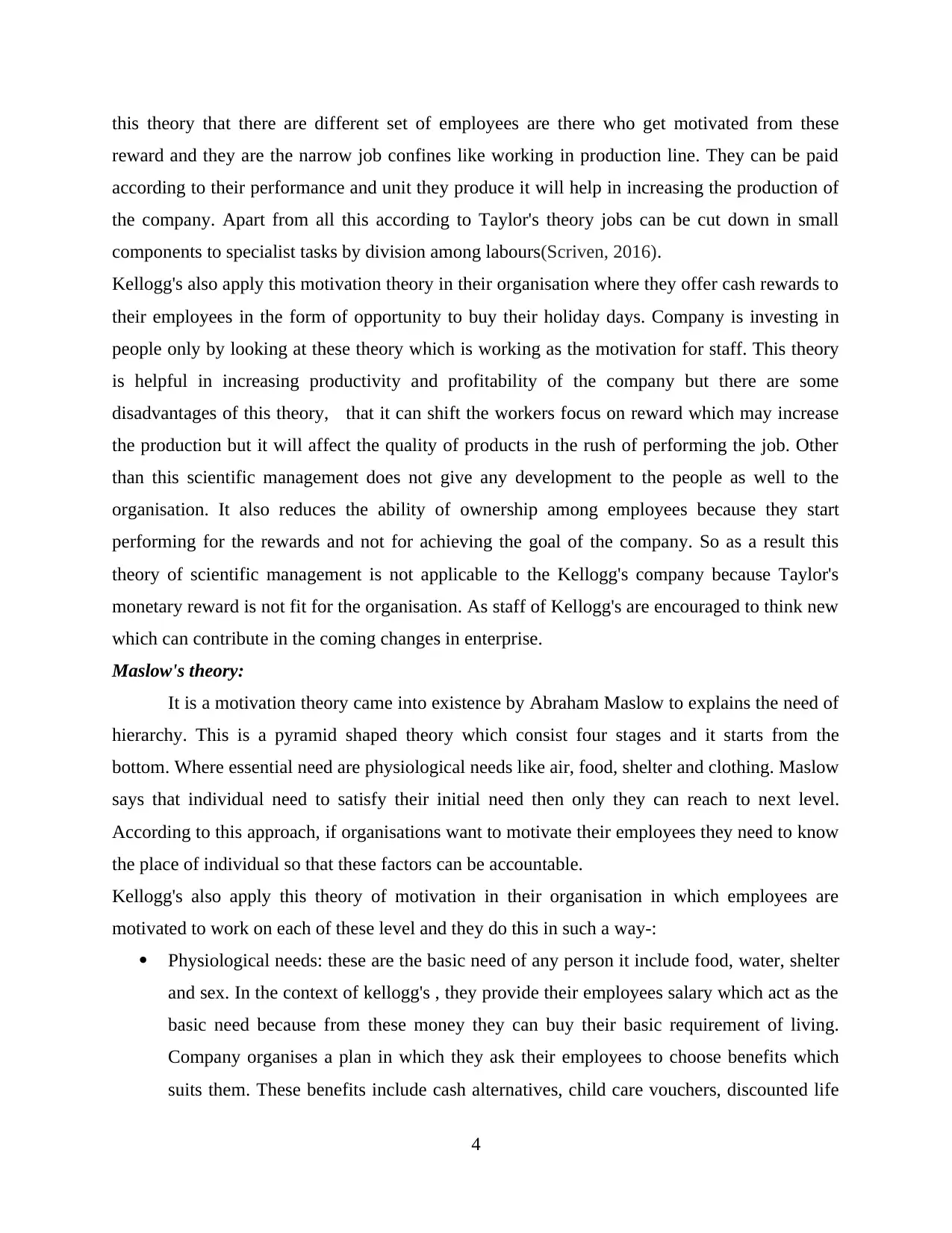
this theory that there are different set of employees are there who get motivated from these
reward and they are the narrow job confines like working in production line. They can be paid
according to their performance and unit they produce it will help in increasing the production of
the company. Apart from all this according to Taylor's theory jobs can be cut down in small
components to specialist tasks by division among labours(Scriven, 2016).
Kellogg's also apply this motivation theory in their organisation where they offer cash rewards to
their employees in the form of opportunity to buy their holiday days. Company is investing in
people only by looking at these theory which is working as the motivation for staff. This theory
is helpful in increasing productivity and profitability of the company but there are some
disadvantages of this theory, that it can shift the workers focus on reward which may increase
the production but it will affect the quality of products in the rush of performing the job. Other
than this scientific management does not give any development to the people as well to the
organisation. It also reduces the ability of ownership among employees because they start
performing for the rewards and not for achieving the goal of the company. So as a result this
theory of scientific management is not applicable to the Kellogg's company because Taylor's
monetary reward is not fit for the organisation. As staff of Kellogg's are encouraged to think new
which can contribute in the coming changes in enterprise.
Maslow's theory:
It is a motivation theory came into existence by Abraham Maslow to explains the need of
hierarchy. This is a pyramid shaped theory which consist four stages and it starts from the
bottom. Where essential need are physiological needs like air, food, shelter and clothing. Maslow
says that individual need to satisfy their initial need then only they can reach to next level.
According to this approach, if organisations want to motivate their employees they need to know
the place of individual so that these factors can be accountable.
Kellogg's also apply this theory of motivation in their organisation in which employees are
motivated to work on each of these level and they do this in such a way-:
Physiological needs: these are the basic need of any person it include food, water, shelter
and sex. In the context of kellogg's , they provide their employees salary which act as the
basic need because from these money they can buy their basic requirement of living.
Company organises a plan in which they ask their employees to choose benefits which
suits them. These benefits include cash alternatives, child care vouchers, discounted life
4
reward and they are the narrow job confines like working in production line. They can be paid
according to their performance and unit they produce it will help in increasing the production of
the company. Apart from all this according to Taylor's theory jobs can be cut down in small
components to specialist tasks by division among labours(Scriven, 2016).
Kellogg's also apply this motivation theory in their organisation where they offer cash rewards to
their employees in the form of opportunity to buy their holiday days. Company is investing in
people only by looking at these theory which is working as the motivation for staff. This theory
is helpful in increasing productivity and profitability of the company but there are some
disadvantages of this theory, that it can shift the workers focus on reward which may increase
the production but it will affect the quality of products in the rush of performing the job. Other
than this scientific management does not give any development to the people as well to the
organisation. It also reduces the ability of ownership among employees because they start
performing for the rewards and not for achieving the goal of the company. So as a result this
theory of scientific management is not applicable to the Kellogg's company because Taylor's
monetary reward is not fit for the organisation. As staff of Kellogg's are encouraged to think new
which can contribute in the coming changes in enterprise.
Maslow's theory:
It is a motivation theory came into existence by Abraham Maslow to explains the need of
hierarchy. This is a pyramid shaped theory which consist four stages and it starts from the
bottom. Where essential need are physiological needs like air, food, shelter and clothing. Maslow
says that individual need to satisfy their initial need then only they can reach to next level.
According to this approach, if organisations want to motivate their employees they need to know
the place of individual so that these factors can be accountable.
Kellogg's also apply this theory of motivation in their organisation in which employees are
motivated to work on each of these level and they do this in such a way-:
Physiological needs: these are the basic need of any person it include food, water, shelter
and sex. In the context of kellogg's , they provide their employees salary which act as the
basic need because from these money they can buy their basic requirement of living.
Company organises a plan in which they ask their employees to choose benefits which
suits them. These benefits include cash alternatives, child care vouchers, discounted life
4
⊘ This is a preview!⊘
Do you want full access?
Subscribe today to unlock all pages.

Trusted by 1+ million students worldwide
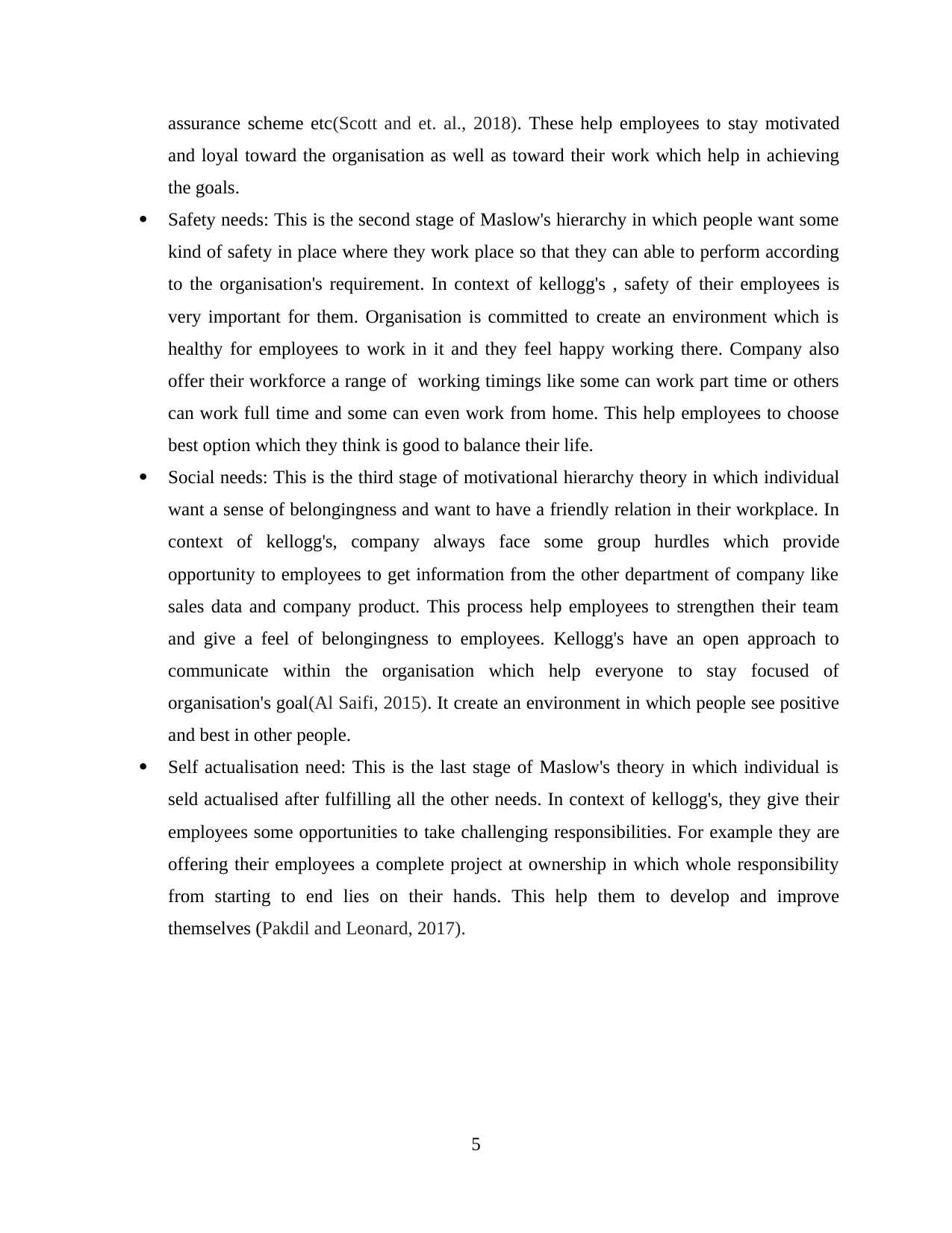
assurance scheme etc(Scott and et. al., 2018). These help employees to stay motivated
and loyal toward the organisation as well as toward their work which help in achieving
the goals.
Safety needs: This is the second stage of Maslow's hierarchy in which people want some
kind of safety in place where they work place so that they can able to perform according
to the organisation's requirement. In context of kellogg's , safety of their employees is
very important for them. Organisation is committed to create an environment which is
healthy for employees to work in it and they feel happy working there. Company also
offer their workforce a range of working timings like some can work part time or others
can work full time and some can even work from home. This help employees to choose
best option which they think is good to balance their life.
Social needs: This is the third stage of motivational hierarchy theory in which individual
want a sense of belongingness and want to have a friendly relation in their workplace. In
context of kellogg's, company always face some group hurdles which provide
opportunity to employees to get information from the other department of company like
sales data and company product. This process help employees to strengthen their team
and give a feel of belongingness to employees. Kellogg's have an open approach to
communicate within the organisation which help everyone to stay focused of
organisation's goal(Al Saifi, 2015). It create an environment in which people see positive
and best in other people.
Self actualisation need: This is the last stage of Maslow's theory in which individual is
seld actualised after fulfilling all the other needs. In context of kellogg's, they give their
employees some opportunities to take challenging responsibilities. For example they are
offering their employees a complete project at ownership in which whole responsibility
from starting to end lies on their hands. This help them to develop and improve
themselves (Pakdil and Leonard, 2017).
5
and loyal toward the organisation as well as toward their work which help in achieving
the goals.
Safety needs: This is the second stage of Maslow's hierarchy in which people want some
kind of safety in place where they work place so that they can able to perform according
to the organisation's requirement. In context of kellogg's , safety of their employees is
very important for them. Organisation is committed to create an environment which is
healthy for employees to work in it and they feel happy working there. Company also
offer their workforce a range of working timings like some can work part time or others
can work full time and some can even work from home. This help employees to choose
best option which they think is good to balance their life.
Social needs: This is the third stage of motivational hierarchy theory in which individual
want a sense of belongingness and want to have a friendly relation in their workplace. In
context of kellogg's, company always face some group hurdles which provide
opportunity to employees to get information from the other department of company like
sales data and company product. This process help employees to strengthen their team
and give a feel of belongingness to employees. Kellogg's have an open approach to
communicate within the organisation which help everyone to stay focused of
organisation's goal(Al Saifi, 2015). It create an environment in which people see positive
and best in other people.
Self actualisation need: This is the last stage of Maslow's theory in which individual is
seld actualised after fulfilling all the other needs. In context of kellogg's, they give their
employees some opportunities to take challenging responsibilities. For example they are
offering their employees a complete project at ownership in which whole responsibility
from starting to end lies on their hands. This help them to develop and improve
themselves (Pakdil and Leonard, 2017).
5
Paraphrase This Document
Need a fresh take? Get an instant paraphrase of this document with our AI Paraphraser

6
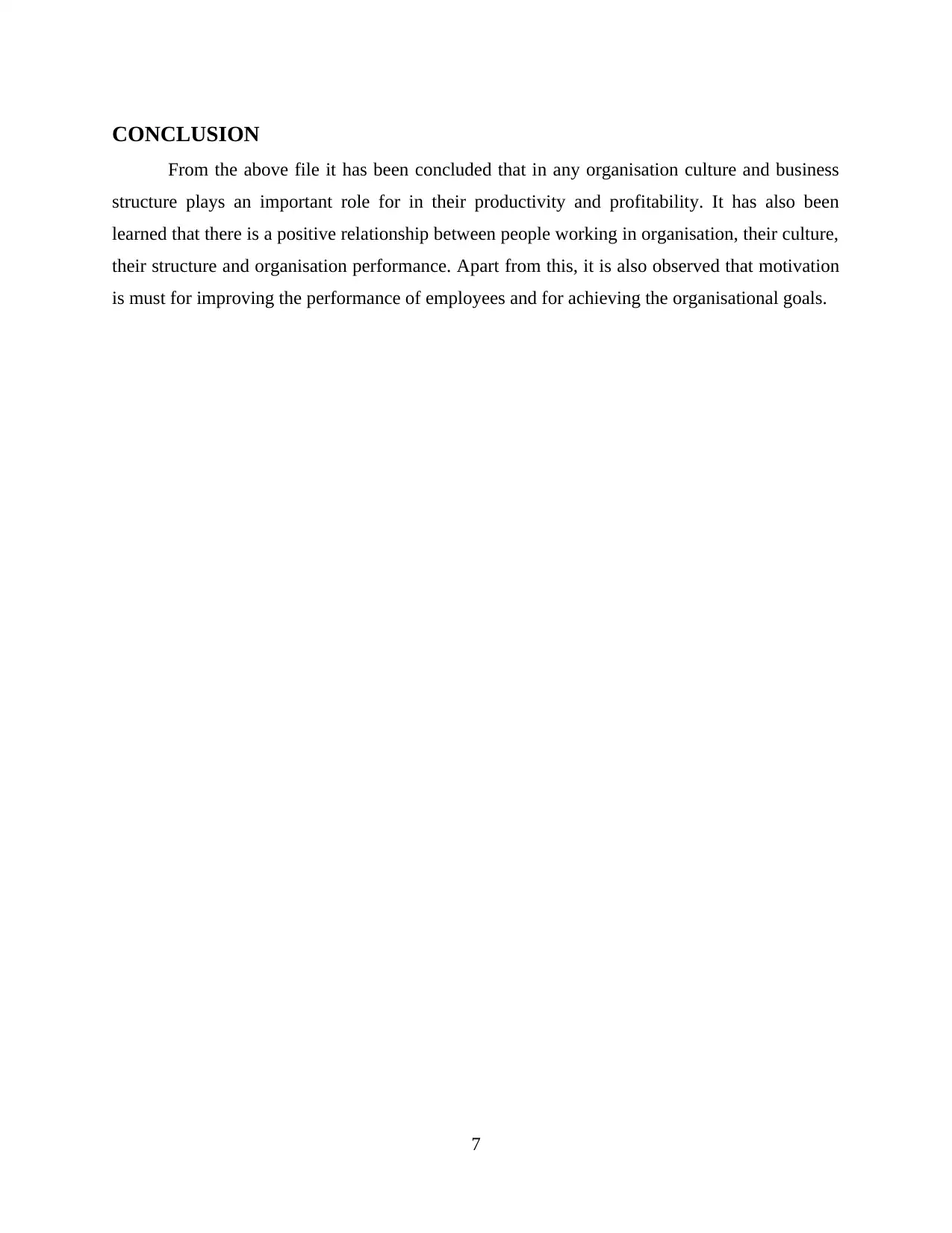
CONCLUSION
From the above file it has been concluded that in any organisation culture and business
structure plays an important role for in their productivity and profitability. It has also been
learned that there is a positive relationship between people working in organisation, their culture,
their structure and organisation performance. Apart from this, it is also observed that motivation
is must for improving the performance of employees and for achieving the organisational goals.
7
From the above file it has been concluded that in any organisation culture and business
structure plays an important role for in their productivity and profitability. It has also been
learned that there is a positive relationship between people working in organisation, their culture,
their structure and organisation performance. Apart from this, it is also observed that motivation
is must for improving the performance of employees and for achieving the organisational goals.
7
⊘ This is a preview!⊘
Do you want full access?
Subscribe today to unlock all pages.

Trusted by 1+ million students worldwide
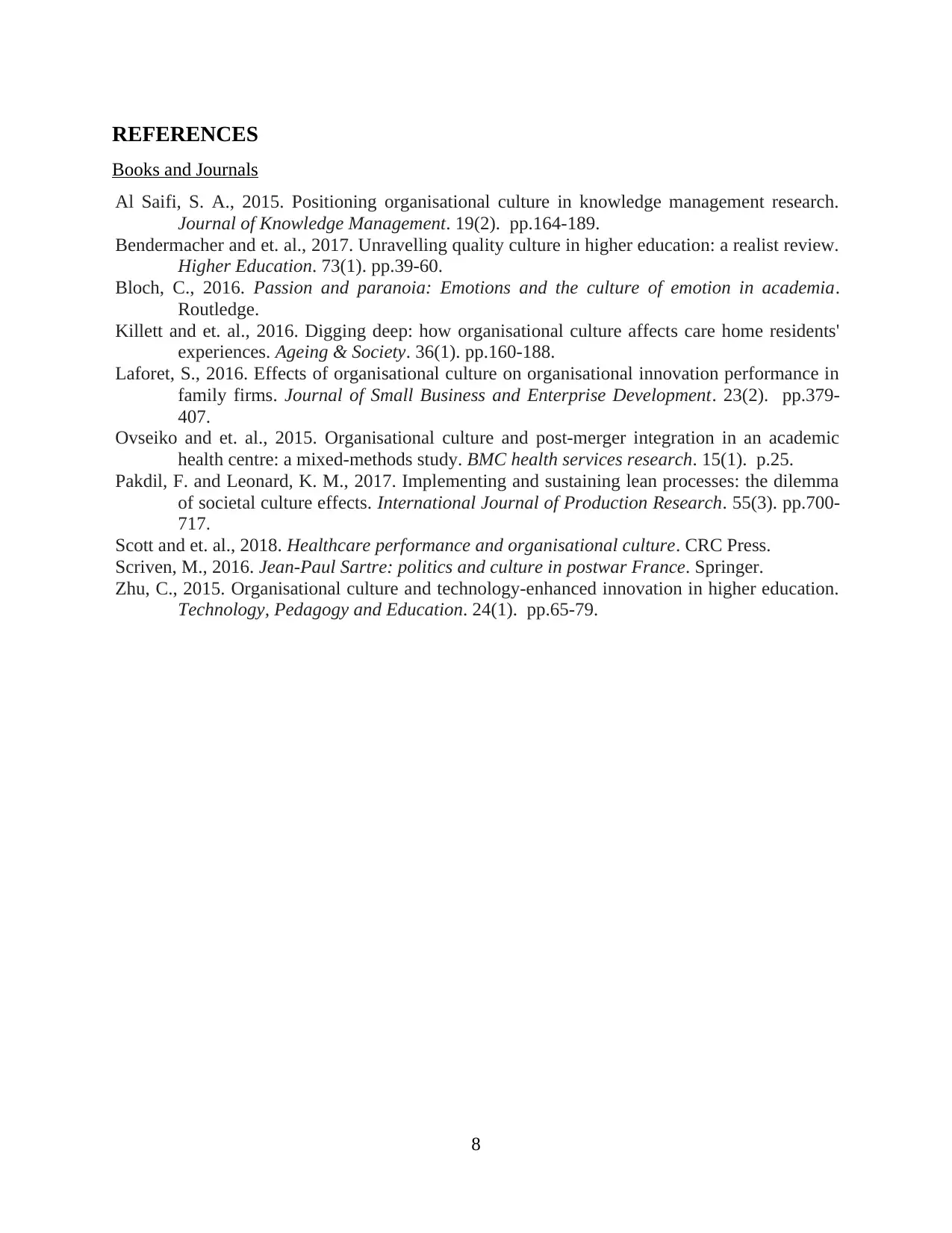
REFERENCES
Books and Journals
Al Saifi, S. A., 2015. Positioning organisational culture in knowledge management research.
Journal of Knowledge Management. 19(2). pp.164-189.
Bendermacher and et. al., 2017. Unravelling quality culture in higher education: a realist review.
Higher Education. 73(1). pp.39-60.
Bloch, C., 2016. Passion and paranoia: Emotions and the culture of emotion in academia.
Routledge.
Killett and et. al., 2016. Digging deep: how organisational culture affects care home residents'
experiences. Ageing & Society. 36(1). pp.160-188.
Laforet, S., 2016. Effects of organisational culture on organisational innovation performance in
family firms. Journal of Small Business and Enterprise Development. 23(2). pp.379-
407.
Ovseiko and et. al., 2015. Organisational culture and post-merger integration in an academic
health centre: a mixed-methods study. BMC health services research. 15(1). p.25.
Pakdil, F. and Leonard, K. M., 2017. Implementing and sustaining lean processes: the dilemma
of societal culture effects. International Journal of Production Research. 55(3). pp.700-
717.
Scott and et. al., 2018. Healthcare performance and organisational culture. CRC Press.
Scriven, M., 2016. Jean-Paul Sartre: politics and culture in postwar France. Springer.
Zhu, C., 2015. Organisational culture and technology-enhanced innovation in higher education.
Technology, Pedagogy and Education. 24(1). pp.65-79.
8
Books and Journals
Al Saifi, S. A., 2015. Positioning organisational culture in knowledge management research.
Journal of Knowledge Management. 19(2). pp.164-189.
Bendermacher and et. al., 2017. Unravelling quality culture in higher education: a realist review.
Higher Education. 73(1). pp.39-60.
Bloch, C., 2016. Passion and paranoia: Emotions and the culture of emotion in academia.
Routledge.
Killett and et. al., 2016. Digging deep: how organisational culture affects care home residents'
experiences. Ageing & Society. 36(1). pp.160-188.
Laforet, S., 2016. Effects of organisational culture on organisational innovation performance in
family firms. Journal of Small Business and Enterprise Development. 23(2). pp.379-
407.
Ovseiko and et. al., 2015. Organisational culture and post-merger integration in an academic
health centre: a mixed-methods study. BMC health services research. 15(1). p.25.
Pakdil, F. and Leonard, K. M., 2017. Implementing and sustaining lean processes: the dilemma
of societal culture effects. International Journal of Production Research. 55(3). pp.700-
717.
Scott and et. al., 2018. Healthcare performance and organisational culture. CRC Press.
Scriven, M., 2016. Jean-Paul Sartre: politics and culture in postwar France. Springer.
Zhu, C., 2015. Organisational culture and technology-enhanced innovation in higher education.
Technology, Pedagogy and Education. 24(1). pp.65-79.
8
1 out of 10
Related Documents
Your All-in-One AI-Powered Toolkit for Academic Success.
+13062052269
info@desklib.com
Available 24*7 on WhatsApp / Email
![[object Object]](/_next/static/media/star-bottom.7253800d.svg)
Unlock your academic potential
Copyright © 2020–2025 A2Z Services. All Rights Reserved. Developed and managed by ZUCOL.





